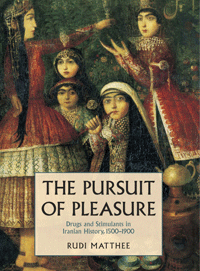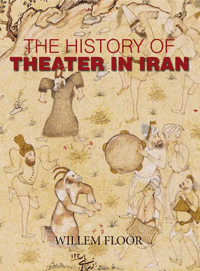
Being Lolita in Tehran
Azar Nafisi's observations
of post-revolution Iran from Olympian heights
June 30, 2005
iranian.com
Well, then, eliminate the people, curtail
them, force them to be silent. Because the European Enlightenment
is more important than people. -- Fyodor Dostoevsky, Notebooks
for Brothers Karamazov (Quoted from Snow by Orhan
Pamuk)
The success of Azar Nafisi's Reading Lolita in
Tehran is by now a matter of record. The book's timely publication
after 9/11 when the public's interest vise a vie the Middle
East was high, its remarkable run on the New York Times best selling
list and Nafisi's well publicized book tour assured the book
was widely reviewed.
This is then not a book review as such, the
interested reader will find plenty of that elsewhere. What I'm
interested in is the politics of Nafisi's book and the case
study it offers of the uneasy, asymptotic relationship between
modern Iranian intellectuals and the Iranian society; between an
intelligentsia which came of age as the result of the contact with
the West and a society knee deep in tradition. The modern intellectuals
and the greater society in Iran throughout the last eighty years
or so have danced to their own tune, brushed against each other
occasionally but have never truly made contact.
As the book's subtitle
announces, Reading Lolita in Tehran is
no straightforward memoirs but "a memoir in books". Briefly,
the book's centerpiece is the informal weekly readings of
Anglo-American literature Nafisi conducted with a select group
of her former students who kept in touch with her after she'd
resigned from her post at Allameh Tabatabi University in Tehran. The
book is divided into four parts, each named after one of the author's
favorite books or writers: Lolita, Gatsby, James
(as in Henry James) and Austen (of the Pride and Prejudice and
Sense and Sensibility fame). The author revisits the events of
the 18 years prior to her departure from Iran for the United States
in context of her reading of the classics of the Anglo-American
literature.
In Nafisi's reading, Nabokov's Lolita becomes
an allegory for tyranny; Gatsby's tragic fall and crushed
dreams a parallel to the dreams of the Iranian revolution; James's
conception of the place of the artist in relation to her society
a beacon for the author herself; and Pride and Prejudice a mirror
of Iranian womanhood condemned by a patriarchal society to her
virginal solitude and labyrinthine inner life.
For a book that
purports to abhor the naked role of politics in literature Reading
Lolita in Tehran is awash in politics, and this is nowhere
clearer than the book's central conceit, Nafisi's reading of
events in Iran through the lens of Anglo-American literature. This
may seem natural since the author is after all a teacher of English
literature but I think this looking outward -- Westward -- is
a clearly political act.
This looking to the West is the antithesis
of what the Iranian revolution set out to do -- looking away from
the West, inward. Nafisi's dilemma is the same as Iranian
intellectuals in the past eighty years. Tradition or modernity?
Unfortunately
her articulations are more often than not ahistorical and disconnected.
Throughout the book, Nafisi makes a number of
bold, brash statements regarding the players in Iranian politics,
the role of writer in her society, theory of novel, etc, mostly
only hinted at with minimal elaboration(1).
As I got further and
further into the book I had the nagging feeling that I was reading
a travelogue, the eye witness account of a tourist trapped in a
cruel and exotic land who finally managed to escape her captors
and return home.
It's 1979, only weeks after the overthrow of the
Pahlavis when a young Nafisi arrives in Tehran after a stretch
at a Suisse
boarding school and a longer one at Norman, Oklahoma, breathless
and fresh-faced clutching a PhD, flushed with Fitzgerald, Mike
Gold and Nabokov, eager to educate the natives to the subtleties
of James and tragic beauty of Gatsby. But much to her chagrin she
finds the natives unwilling and the universities dominated by the
red and black reactionaries.
Except for a few students (naturally
mostly women in this book) the student body consists of underdeveloped
minds in an underdeveloped country. Nafisi loves her country, wants
to lift it from its aesthetic poverty but this love must be strictly
on her terms (crack the whip professor. It's for their own
good, the poor bastards).
History, as presented in Reading Lolita
in Tehran starts when Nafisi arrives back in Tehran. Except for
a brief mention of her father's trouble as Tehran's
mayor with the former regime, there is no evidence of the sequence
of events that led to 1979. Of course Nafisi is not a historian
and no one should expect a historical analysis from a book of memoirs,
except that the author insists on issuing sweeping judgments on
everything and everyone from her ivory tower.
No mere peasant Ms.
Nafisi (she of long standing cultural family, the daughter of a
former mayor no less), she would, following Nabokov's example,
observe the events from the Olympian heights of literature rather
than participating in them. No earlier has she started teaching
in the university that she becomes disgusted with the general turn
of events. "... as time went by, it was the values inherent
in Gatsby that would triumph but at the time we had not yet realized
just how far we had betrayed our dreams."
What dreams and
whose dreams exactly? Like most of her broad statements
Nafisi doesn't elaborate.
 The main problem with the Iranian
revolution was that there was no articulated dream. There was mostly
a hatred
of the Shah that bordered on pathological and a desire to get rid
of him at any cost. The highly polarized opposition had no clear
vision (or dream for that matter) of the future. Even the clergy
played their hand as they went along, unsure of the future since
the Shah's
rule was perceived as unbreakable. The main problem with the Iranian
revolution was that there was no articulated dream. There was mostly
a hatred
of the Shah that bordered on pathological and a desire to get rid
of him at any cost. The highly polarized opposition had no clear
vision (or dream for that matter) of the future. Even the clergy
played their hand as they went along, unsure of the future since
the Shah's
rule was perceived as unbreakable.
Having witnessed the Stalinist
tactics of the Confederation of Iranian Students Abroad and hence
cured of any overt political interest, Nafisi expresses revulsion
at the rash of executions of the former regime's lynchpins
in the immediate aftermath of the revolution.
The way Nafisi juxtaposes
the events, moving from her traumatic experience with the Confederation
to the post-revolutionary executions is characteristic of her ahistorical
and wishy-washy approach, and one might say revealing of her politics(2).
For instance, It would've been nice for the author
to have mentioned that the Confederation (as it was know back in
the 60'
and 70') was regularly infiltrated by the SAVAK, their leadership
and rank and file members often beaten up and punished by the
regime. Their paranoia was not without basis and their behavior
not simply
a symptom of the memberships' sadism.
Yes, the Confederation
did employ Stalinist tactics in resolving their internal conflicts
(who didn't back then? Right, Left and Centre all employed
the same tactics) and were often politically naïve and misguided
but they also worked hard in exposing the abuses of political rights
in Iran in spite of the regime's expensive and very effective
public relation campaign abroad. This selectivity of the events
as presented by an author who trumpets the democratic nature of
the novel, is telling.
Nafisi rightfully mourns the grotesque nature
of the executions after the revolution. I'm not familiar
with the case of the gentleman friend of Nafisi's but I assume
her former high school principal executed by the revolutionary
courts must be Ms. Farrokhrou Parsa, the former Minister of Education
for life in the cabinet of the former Prime Minister for life,
Hoveyda. Kangaroo courts are despicable and dehumanizing under
any name: lynching party, people's court, revolutionary tribunals,
Military tribunals. They dehumanize both the victims and their
executioners.
But to paraphrase Mr. Bahri, the nasty villain of
the first part of the book, there was a revolution going on. The
cycle of violence that concluded in 1979 had indeed started 25
years earlier in 1953 when the Anglo-American coup toppled Mossadegh's
government. Hundreds of regime's opponents, including army
officers, writers and poets and social activists were tortured,
executed and sentenced to long prison sentences.
 Having destroyed
all semblance of a democratic framework, the regime then ruled
mostly by fear (the dreaded SAVAK) and graft, and then later on
was briefly boosted by a boom in oil revenues that trickled down
and benefited a thin layer of the middle class. Having destroyed
all semblance of a democratic framework, the regime then ruled
mostly by fear (the dreaded SAVAK) and graft, and then later on
was briefly boosted by a boom in oil revenues that trickled down
and benefited a thin layer of the middle class.
For 25 years the
state monopolized political violence. After years of resentment
and oppression, in those heady days after the Pahlavis were gone,
revenge was the currency of the land. The members of the former
regime reaped what they had sown. The hangmen also die, something
worth remembering for everyone. When the big machinery of violence
is set in motion, the beast acquires a life of its own and is not
easily harnessed.
Had Nafisi gone back to Iran a year earlier and
witnessed the bloody demonstrations in the streets of Tehran, the
carnage of 17th of Sharivar, the morgues full of bodies, the spectacle
of daily burials, the massive tanks patrolled by fully armed soldiers
parked outside of high schools which at times shot up unarmed students,
maybe she would have understood why the average Tehrani didn't
shed much tear for the bullet ridden bodies of Hoveida or Parsa.
Revenge may be ugly but it's an all too human emotion.
And
of course there were other factors. The new regime still vulnerable
and shaky wanted to demoralize the supporters of the old regime
by showing off the bodies of its former leadership. The showcased
brutality of the executions was also a warning for the folks
who fancied themselves the future opposition, namely the Marxist
Left
and the Mojahedin-e Khalgh.
It is in relation to her disgust
at the brutality of the revolutionaries and their corresponding
aesthetic poverty that Nafisi shows her
most vociferous contempt for the Marxist Left, even more so
than the purveyors of the current regime, for they are at least
players
in her narrative whereas the Marxist Left (including some of
her students) are relegated to the sidelines. She bestows some
of her
vast humanity to the likes of Mr. Bahri and the disillusioned
Hezbollah student who sets himself on fire in a hopeless
protest against
indifference, but the Left doesn't even deserve her glance. Were it not for her own admission that she gave up
on Leftist politics before returning to Iran (thanks to the thugs
of the
Confederation)
her bitterness would have smelled the rancor of an ex-fellow
traveler. This contempt, though not quite undeserving, is
just a tad self-serving.
Because even as hundreds of the Left's young sympathizers
were being imprisoned and executed during the Eighties, some
of whom possibly Nafisi's students, the closest Nafisi ever
came to putting her neck on the line was refusing to wear
the hijab. Big deal!
 In one of the book's several half-baked statements,
Nafisi declares that the realistic novel never took roots in
Iran. "These readings made me curious about the origins of novel
and what
I came to understand as its basically democratic structure.
And I
became curious as to why the realistic novel was never
truly
successful in our country." This again is really a sweeping
political statement disguised as theory of novel. In one of the book's several half-baked statements,
Nafisi declares that the realistic novel never took roots in
Iran. "These readings made me curious about the origins of novel
and what
I came to understand as its basically democratic structure.
And I
became curious as to why the realistic novel was never
truly
successful in our country." This again is really a sweeping
political statement disguised as theory of novel.
Nafisi's
implication
seems to be this: novel as originated in 18th century
Europe is
a democratic form. The novel requires a sense of empathy
for all characters, a cacophony of voices. The realist
novel never
took
real root in Iran therefore Iran's political culture
is incapable of fostering democracy, unless perhaps through a
wholesale dumping of its past and acceptance of the West? An attractive
theory
on the surface with its allusions to Asiatic despotism
and
Islam, and one espoused by scores of so-called Orientalists.
But the actual
record of Iranian literature seems to suggest otherwise.
I may
not hold a PhD in literature but how do you classify the novels
and short stories of Simin Daneshvar, Ale Ahmad, Choobak, Hedayet,
Dolatabadi, Golshiri, Golestan and others. The subject matter
of these writers' books was the every day realities of their
society, rendered in a realist, non-allegorical language containing
a multiple of psychologically varied characters. Nafisi's
negligence of this body of literature seems to stem from her dislike
for their often politicized content. She doesn't like them
because they don't fit her concept of literature.
It's
true that a large part of literature and arts in Iran before the
revolution was overtly political but not all writers and poets
fit that notion. Socialist realism had its advocates but ultimately
the presence of politics in literature was simply a refection of
the realities of the society, as has been the case in Latin American
and the greater Indian literature.
Ultimately there is only good
literature and bad literature. Brecht produced some very good art
even though he saw himself as a cultural worker. Gorky wasn't
the vulgar writer that Nafisi makes him to be (in this she seems
to be repeating Nabokov, whose lack of generosity extended even
to the likes of Joyce) even though he did produce some mediocre
work. T.S Eliot was a great poet and an anti-Semite. In her dislike
for one group of cultural commissars, Nafisi becomes one herself
when she sermonizes about the role of fiction.
This rather hysterical
revulsion at the role of politics in literature is most telling
from her reading of the phrase "The personal
is political", which is surprisingly sophomoric coming from
an academic. The often quoted expression, "The personal is
political" during the activist 60's and 70's
in Western Europe and North America (ironically by the Women's
Lib movement), links personal acts to a greater political picture.
So a woman's right to her body is connected to defense of other
democratic rights in the entire society.
It's bizarre that
a book which makes the very personal act of a group of women getting
together, in the manner of a Tupperware party, and read books into
an act of transgression; that rhapsodizes about one woman's
wearing a sexy dress under the chador as an act of social defiance,
derides the expression "The personal is political". Of
course what Nafisi is rightfully protesting is the dissolution
of boundaries between the personal and private, and the public
and political spheres; the collapse of civil society and its dominance
by the state. But what does that have to do with "The personal
is political"?
 Throughout the book there is an
underlying theme that what Iran needed was a greater exposure to
the West and specifically vis a vis aesthetics, Western literature(3);
that denying herself of Western literature and culture contributed
to an aesthetic
poverty and a reactionary revolution. But translating Anglo-American
literature as well as works from French, German, Russian and Spanish
to Persian was a whole industry in pre-revolutionary Iran. Hundreds
of titles were translated. Hemingway, Faulkner, Virginia Wolfe,
and Fitzgerald (of whom readers were aware before Nafisi went back
to Iran) were well known writers along with Proust and Lorca and
Aragon, Heidegger, Russell, etc. Throughout the book there is an
underlying theme that what Iran needed was a greater exposure to
the West and specifically vis a vis aesthetics, Western literature(3);
that denying herself of Western literature and culture contributed
to an aesthetic
poverty and a reactionary revolution. But translating Anglo-American
literature as well as works from French, German, Russian and Spanish
to Persian was a whole industry in pre-revolutionary Iran. Hundreds
of titles were translated. Hemingway, Faulkner, Virginia Wolfe,
and Fitzgerald (of whom readers were aware before Nafisi went back
to Iran) were well known writers along with Proust and Lorca and
Aragon, Heidegger, Russell, etc.
True, there were some very bad
translations but there were also excellent ones. I myself read
JD Salinger's Catcher in the Rye in Persian as a teenager
and having read the English text several times since then have
to admit that the Iranian translator truly captured the spirit
of the book as well as any translation could (I read Charles Bukowski
in Persian, also translated by the same translator).
I submit that
the problem wasn't so much that Iranian intellectuals (for
I assume Nafisi did not expect semi-literate folks in rural areas
or the urban poor to read and learn from the classics) read too
little foreign texts, that they read too little of their own literature
and history. I submit that they were disconnected and ahistorical.
Ale Ahmad called this Gharbzadegi. His tone and his traditionalist
approach was wrong but his symptomology was spot on. And that their
reading of the European and American classics seldom crossed awestruck
mimicry into production of a genuine national literature.
Maybe
instead of reading Hemingway for the hundredth time, they should
have read Naguib Mahfouz's The Cairo Trilogy (a disciple
of Balzac by his own account and an ardent secularist) or Garcia
Marquez's One hundred Years of Solitude or, to give a
current example, Orhan Pamuk's Snow. Not that there weren't
some very good attempts. Mahmoud Dolatabadi's rural novels,
Ale Ahamd's own urban stories, Daneshvar's singular
Soovashoon, among others, were all with varying degrees of success
efforts to articulate a modern Iranian literature. And that's
what a national literature does: articulate national destiny
in stories of a country's people. It creates a voice that
is particular and concrete and recognizable by the citizens.
 The
failure of Iranian intellectuals was to articulate that grand story,
not that they failed to read enough Fitzgerald or Austen. Austen
and Fitzgerald did that for 18th Century England and Jazz Age America
respectively. The hard work of an intellectual is to burrow into
her society's national psyche through its individuals, create
characters and stories that possess its colours and textures. This
requires the artist to have an intimate sense of the people and
their history, warts and all. Iranian intellectuals though more
often than not have simply wished for the people to go away, to
disappear. Well, the masses won't go away, can't go
away. They can't all immigrate to Europe and America. The
failure of Iranian intellectuals was to articulate that grand story,
not that they failed to read enough Fitzgerald or Austen. Austen
and Fitzgerald did that for 18th Century England and Jazz Age America
respectively. The hard work of an intellectual is to burrow into
her society's national psyche through its individuals, create
characters and stories that possess its colours and textures. This
requires the artist to have an intimate sense of the people and
their history, warts and all. Iranian intellectuals though more
often than not have simply wished for the people to go away, to
disappear. Well, the masses won't go away, can't go
away. They can't all immigrate to Europe and America.
Notes
1) Maybe she did. Maybe her publisher sat her down and said
"Look, Azar. Your target market, the 30-50 white middle-class
female readers
are not interested in the minutiae of political history in Iran.
They want the personal stories. What it feels under the veil in
the Islamic republic. Give them the details, the juicy stuff."
The book's cover itself is just that. A couple of peach-skinned
waifs, the chador slightly slipping over their jet black hair looking
down at something cleverly framed out. What could they be looking
at? What does really go on under the veil?
2) I'll be only guessing about Nafisi's politics although
her boosters at Johns Hopkins, Fouad Adjami and Bernard Lewis,
both neo-con darlings on the Middle East issues, may provide a
hint. As well, there is a faint sense of nostalgia for the good
old days and a reference to the Turkish model. Could Nafisi be
a closet fan of a secular dictatorship backed by an ever watchful
army? I hope not. We've seen that movie before.
3) The kind of literature of course that Nafisi approves, not Philip
Roth, Don DeLillo, Garcia Marquez and Zadie Smith but Nabokov,
James and Borges. By the way when will the Iranian intellectuals
ever leave Modernism behind and enter 21st Century? The great dead
white men (and a few women) were deserving of their reputation
and can still inspire but at least two generations of new writers
have written since Faulkner and Hemingway.
|